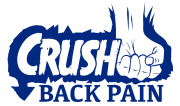Beat back pain permanently
Subscribe to the Crush Back Pain Channel
Powerful Bulging Disc Exercises
What does bulging disc pain look like? Disc pain is made worse with sitting for prolonged periods and bending forward. Difficulty straightening out and being “stuck” after sitting is consistent with disc involvement. When symptoms are consistent with disc related pain these bulging disc exercises will be beneficial. If an MRI shows a bulging disc and symptoms are consistent with disc pain these exercises will be helpful.
These bulging disc exercises promote disc health through three mechanisms.
1.Reduce forces through the posterior (back) part of the disc
2. Facilitate trunk muscle contraction without excessive load through the lumbar spine
3. Mobilize the hips and stabilize the lower back
Two exercises are covered.
- Prone press-up.
- Hip hinge
Prone Press-up
The prone press-up is an important exercise for bulging discs because it works. This exercise has been tested and proven to reduce lower back pain caused by bulging discs. The prone press-up extends the lumbar spine. Bulging discs are caused and exacerbated by lumbar flexion. With the press-up the spine is taken in the opposite direction of flexion, into extension. Consequently, this decreases the load through the posterior (back part) disc. Less load through the posterior disc results in less pain, less inflammation, and less bulging. Considering that most people spend most of their day in a seated position (lumbar flexion) simply extending the lumbar spine is especially important for overall back health. If a bulging disc is causing pain it’s even more important to get the lower back extended and out of flexion.
Hip Hinge
The hip hinge is an essential bulging disc exercise. It can be used as an exercise and needs to be used as the default movement pattern when sitting, standing, and bending forward. The hip hinge minimizes compressive and shear forces through the lumbar spine, protecting the discs. 90% of the motion when bending forward should come from the hips. The hip hinge makes this happen. If the lumbar spine is flexing excessively dozens of times every day while standing and sitting the best exercise program in the world will not be as effective as it could be.
Eliminating or at least minimizing repetitive microtrauma to the discs and other lumbar tissues is usually overlooked with low back pain exercise programs. This needs to be a priority with every program because it’s the foundation to long-term pain relief and optimal function. The hip hinge is the best place to start. In addition to protecting the disc during repetitive movements the hip hinge requires the lumbar multifidus and erector spinae muscles to stabilize the lower back. This is important because stabilization during static and dynamic activity is the primary role these muscles play. Weighted walking for bulging discs is another effective exercise to work on.
For more videos that show you how to beat back pain subscribe to the Crush Back Pain channel


